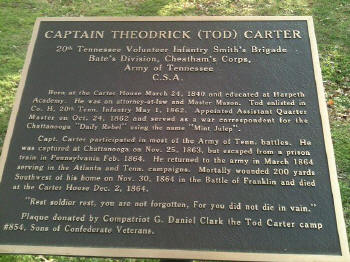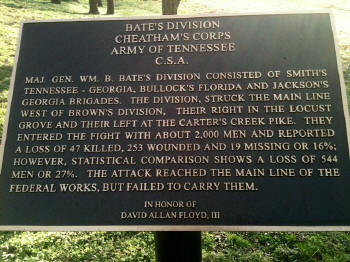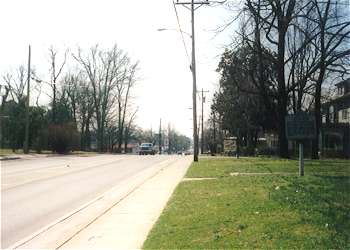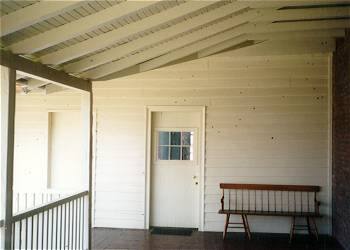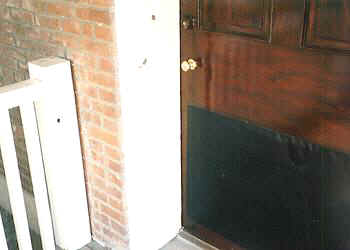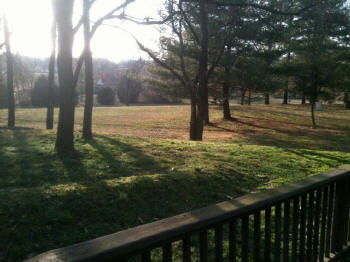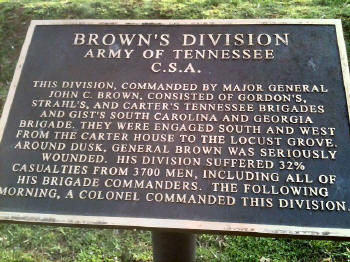|
(January 2013)
Enlarge The Carter House,
1140 Columbia Avenue (wartime Franklin-Columbia Pike)
Interpretive Marker: Captain Theodrick (Tod) Carter
Richard Edling photo |
|
(January 2013)
Enlarge The Carter House
Interpretive Marker: Bate's Division, Cheatham's Corps, Army of
Tennessee C.S.A.
Richard Edling photo |
|
(6-2013) Enlarge
The Carter House
 Additional Carter House Courtesy of Brian
Risher, MS
Additional Carter House Courtesy of Brian
Risher, MS
Central to the battle and its story has always been the home of
Fountain Branch Carter, known as the Carter House. The Carters occupied
their stout brick house along with several neighboring families during the
battle raging outside, sheltering in the rear room of the spacious cellar.
This was necessary because the house stood on the very trench line
established by the Federals as soon as they arrived. The house and its
outbuildings still show the scars of battle there, including where a
Federal soldier kicked in a back-door panel in order to enter the house to
escape the hail of lead!
Outbuildings, above and below, attest to the fury of the battle that raged
in the backyard. Confederates broke through the Union lines here in a
storm of lead, only to be turned back by the timely arrival of Col.
Emerson Opdyke's Federal brigade which had been held in reserve just
behind the Carter property. A fierce hand-to-hand fight ensued, in which
the battle lines were stabilized with Schofield's men on one side of their
entrenchments and Hood's on the other. Following the battle, Confederate
Captain "Tod" Carter, who had been mortally wounded within sight of his
home was brought here where he died two days later
James Neel photo
Site Marker: Built by Fountain Branch
Carter, and in use by three generations of his family. Here was command
post of Maj. Gen. Jacob D. Cox, Federal field commander of Schofield's
delaying action. The hottest fighting took place just east and south
nearby. Capt. Theodore Carter, CSA, a son of the family, was mortally
wounded
 Carter
House Web Site
Carter
House Web Site |
|
(3-95)
The Carter House
Looking south down Columbia Pike
Webmaster photo |
|
(3-95)
Enlarge The Carter House
Back Porch
Webmaster photo | |
(3-95) Back Porch
Blue and Gray Magazine, August-September 1984: A Union soldier
returned to the Carter House after the war, stood on the back porch, pointed
to this doorway and told a story of his struggle to survive the battle of
Franklin. The slice in the wooden louvered door (not shown in the above
photo), the bullet hole in the post, and the patched lower door panel all
play a role in his story. During the battle, so the story goes, he sought
cover in the doorway and soon drew enemy fire. He said the slice in the
outer door and the hole in the post were from bullets aimed at him.
Attempting to return the fire, his ramrod, when sharply drawn, hit the top
of the doorway leaving small dents in the wood (they are still there, but
out of view in the photo magazine photo). When his situation became
untenable, he took the butt of his musket, bashed in the lower door panel,
and crawled through to safety in the house. The Carters later patched the
door with a piece of sheet metal, the same patch which in on the door today
Webmaster photo |
